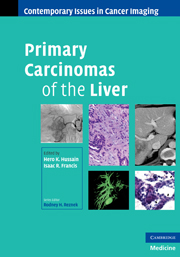Book contents
- Frontmatter
- Contents
- Contributors
- Series foreword
- Preface to Primary Carcinomas of the Liver
- 1 Epidemiology of hepatocellular carcinoma and cholangiocarcinoma
- 2 Surveillance and screening for hepatocellular carcinoma
- 3 Pathology of hepatocellular carcinoma, cholangiocarcinoma, and combined hepatocellular-cholangiocarcinoma
- 4 Radiological diagnosis of hepatocellular carcinoma
- 5 Staging of hepatocellular carcinoma
- 6 Surgical treatment of hepatocellular carcinoma: resection and transplantation
- 7 Non-surgical treatment of hepatocellular carcinoma
- 8 Radiological identification of residual and recurrent hepatocellular carcinoma
- 9 Radiological diagnosis of cholangiocarcinoma
- 10 Staging of cholangiocarcinoma
- 11 Treatment of cholangiocarcinoma
- 12 Uncommon hepatic tumors
- Index
- Color plates
Preface to Primary Carcinomas of the Liver
Published online by Cambridge University Press: 04 August 2010
- Frontmatter
- Contents
- Contributors
- Series foreword
- Preface to Primary Carcinomas of the Liver
- 1 Epidemiology of hepatocellular carcinoma and cholangiocarcinoma
- 2 Surveillance and screening for hepatocellular carcinoma
- 3 Pathology of hepatocellular carcinoma, cholangiocarcinoma, and combined hepatocellular-cholangiocarcinoma
- 4 Radiological diagnosis of hepatocellular carcinoma
- 5 Staging of hepatocellular carcinoma
- 6 Surgical treatment of hepatocellular carcinoma: resection and transplantation
- 7 Non-surgical treatment of hepatocellular carcinoma
- 8 Radiological identification of residual and recurrent hepatocellular carcinoma
- 9 Radiological diagnosis of cholangiocarcinoma
- 10 Staging of cholangiocarcinoma
- 11 Treatment of cholangiocarcinoma
- 12 Uncommon hepatic tumors
- Index
- Color plates
Summary
The incidence of liver cancer in the United States and worldwide is increasing. The majority of primary liver cancers in the United States are hepatocellular carcinomas (HCC), with cholangiocarcinomas being the next most common. This trend is due to an increase in chronic hepatitis C, which along with hepatitis B is a major risk factor for liver cancer. Other contributing factors include heavy alcohol consumption, fatty liver disease, obesity, diabetes mellitus, and iron storage diseases. Although in general the mortality rates are high, survival rates in some countries are showing some improvement as more patients are being diagnosed with earlier stage tumors by means of aggressive surveillance with serologic tumor markers and diagnostic imaging. Advances in imaging techniques such as diffusion-weighted magnetic resonance imaging (MRI) and positron emission tomography–computed tomography (PET–CT) have helped in improving the detection and characterization of smaller earlier stage tumors. Treatment by means of resection or transplantation has excellent survival rates and, for patients who are not surgical candidates, ablative therapies and transarterial chemoembolization are suitable alternatives. Recently, for advanced HCC, anti-angiogenic agents have been employed with encouraging results. The role of radiotherapy in patients with cholangiocarcinoma and HCC who are poor surgical candidates is increasing.
The purpose of this edition of Contemporary Issues in Cancer Imaging is to review the epidemiology, screening, and diagnostic imaging techniques as well as roles of various therapeutic management strategies of common primary hepatic malignancies.
- Type
- Chapter
- Information
- Primary Carcinomas of the Liver , pp. xi - xiiPublisher: Cambridge University PressPrint publication year: 2009

